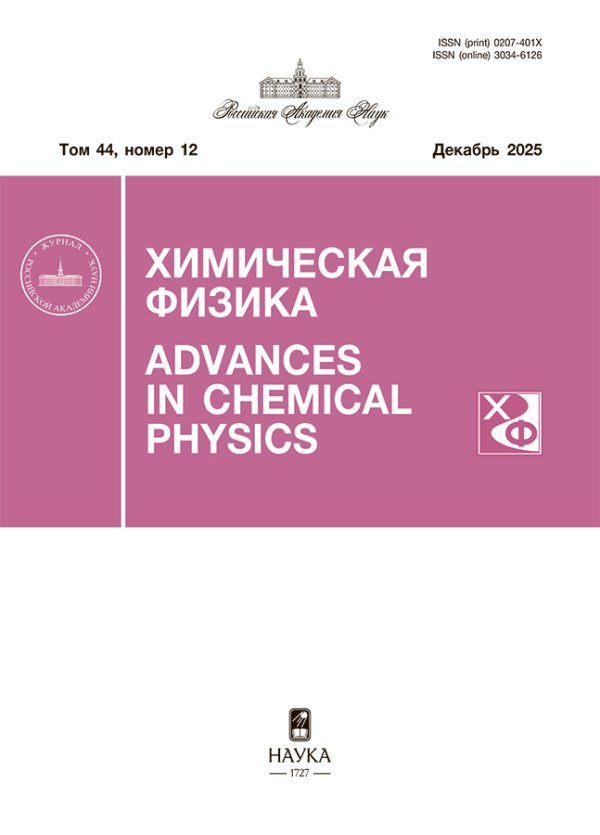Vol 42, No 6 (2023)
К 100-ЛЕТИЮ СО ДНЯ РОЖДЕНИЯ АКАДЕМИКА В.И. ГОЛЬДАНСКОГО
DNA Condensation in Bacteria
Abstract
Deoxyribonucleic acid (DNA) is organized hierarchically in the nucleoid of an actively growing cell, with three levels of DNA compaction. The lower level (small scale ≥1 kb base pairs (bps)) is provided by the interaction with DNA-bound proteins. Actively growing cells maintain a dynamic, far from equilibrium order through metabolism. When cells enter a dormant state (almost complete absence of metabolism), the usual biochemical methods of protecting DNA cease to work, and the cells, adapting to the new conditions, are forced to use the physical mechanisms of DNA protection. The structure of DNA in the nucleoid of dormant cells formed during starvation stress is studied using synchrotron radiation diffraction and transmission electron microscopy (TEM). The experimental results make it possible to visualize the structures of the lower hierarchical level of DNA compaction in the nucleoid of dormant cells. A series of diffraction experiments conducted for the first time indicate the presence of a periodic ordered organization of DNA in all the studied bacteria. The TEM method made it possible to extract fine visual information about the type of DNA condensation in the nucleoid of the bacterium Escherichia coli (E. coli). Intracellular nanocrystalline, as well as liquid-crystalline and folded nucleosome-like, structures of DNA are found. The folded nucleosome-like structure was observed for the first time and is the result of the multiple folding of long DNA molecules around the DNA-binding protein (Dps) of starved cells and its associates. The different types of condensed state of DNA found by us in the studied dormant E. coli cells (DNA condensation heterogeneity) provide additional arguments in favor of the concept that considers a microbial population as a multicellular organism. The study of changes in the DNA architecture under the effect of the chemical analog of the autoinducer of anabiosis 4-hexylresorcinol (4-HR) is studied. An increase in the 4-HR concentration induces the transition of a part of the cells of the population to anabiotic dormant state, and then to a mummified state. The studies of the structure of DNA in the anabiotic and mummified states show the spectroscopic identity of the DNA structure in the dormant anabiotic state and in the dormant state formed during starvation stress. Studies of the structure of DNA in the mummified state show a strong difference from the structure of DNA in the anabiotic state.
 3-20
3-20


Euler Arches and Duffing Springs of a Few Nanometers in Size
Abstract
The molecular dynamics of a rod-like oligomer of N-isopropylmethacrylamide and helical oligomers of pyridine-furan several nanometers in size are studied by full-atomic computer simulation. It is shown that, under compression and tension, the dynamics of the oligomers are similar to the dynamics of classical bistable constructions such as Euler arches and Duffing oscillators. The critical values of power loads at which the dynamic states of oligomers bifurcate and the dynamics of oligomers become bistable are determined. It is shown that in the region of bistability oligomers can switch to the regime of spontaneous vibrations activated by thermal fluctuations of the environment at room temperature. For the regime of spontaneous vibrations, the effect of stochastic resonance is demonstrated. The possibility of using bistable oligomers for the detection of single organic molecules in solutions is discussed.
 21-39
21-39


Why Do Proteins Fold into Unique 3D Structures? And Other Questions…
Abstract
The article briefly reviews the history of the development of ideas about the dynamics of proteins and other biopolymers and notes the significant contribution of V.I. Goldansky in organizing and conducting these studies in Russia. The modern development of earlier ideas about the dynamics of biopolymers and protein folding is discussed. It is shown that folding is not an isolated problem and is related to the fundamental dynamic properties of linear polymers in the condensed phase. Analytical methods using approaches based on multidimensional geometry show that the viscosity of the medium is one of the most important factors that determines the rules for the movement of a representative point along the ultramultidimensional potential energy surface (PES). These rules lead to the concentration of trajectories in those regions of the configuration space of a macromolecule that correspond to relatively smooth PES regions, which is important for understanding the reasons for the stability of the results of calculations of large systems using the molecular dynamics (MD) method, despite the fundamental inaccuracy in determining the available force fields. This article also briefly describes a new approach to determine and study the properties of a multidimensional PES, which is based on the features of the topology of the configuration space of linear polymers (and biopolymers), symmetry with respect to permutations of identical chain links, and Morse theory for studying the topography of multidimensional surfaces. Under certain conditions, this approach gives observable analytical results for the topography of the PES and the free energy surface (FES) of a macromolecule and makes it possible to relate the rather heterogeneous results of experiments on protein folding from a unified point of view. At the same time, a new formulation appears for a number of fundamental and controversial issues related to the physical laws of the formation of living systems. In particular, a connection is traced between the temperature regime on the planet and the chemical realization of the energy of nonvalent interactions in a macromolecule, which are necessary for the formation of unique spatial structures of biopolymers.
 40-62
40-62


Temperature Dependence of the Nonlinear Dynamics of the Deactivation of Excited States of Tryptophan in Various Media
Abstract
The authors’ research on the dynamics of the excited states of tryptophan in various solvents as a function of temperature (–170 to +20°С) is presented. The antibatic behavior of the temperature dependences of the decay times of two components (fast and medium) of tryptophan fluorescence is found in the temperature range from –60 to +10°C. The third, slow, component shows a weak dependence on temperature. The antibatic behavior of the decay times of two components of the fluorescence kinetics is modeled under the assumption that, in a certain temperature range, some of the tryptophan molecules in the excited state pass from the short-wavelength rotamer B-form, which has a short fluorescence lifetime, to the long-wavelength rotamer R-form, with an intermediate fluorescence lifetime. To explain the observed changes in the spectra and duration of tryptophan fluorescence depending on temperature, a new model of the transitions between the excited and ground states using the charge transfer state (CTS), which takes into account the nonlinear nature of the dynamics of these transitions, is also developed. In these processes, an important role is played by the interaction of tryptophan molecules with its microenvironment and the rearrangements in the system of hydrogen bonds in the environment of the tryptophan molecule. Three main spectral regions of tryptophan fluorescence, which differ in the behavior of the temperature dependences of the rates of transition from the excited state of tryptophan to CTS, are distinguished. The key role of the dynamics of the hydrogen bond system, which determine the nonlinear nature of the change in tryptophan fluorescence parameters in the selected spectral regions, is shown.
 63-76
63-76


Dipole Moment of the S0 → S1 Chlorophyll a Transition in Solvents with a Varied Refraction Index
Abstract
The dependence of the dipole moment of chlorophyll a’s (Chl) S0 → S1 transition on the value of the solvent refractive index n is calculated. The interactions between the electric field of a light wave, the electronic transition of the pigment to an excited state, and the dielectric polarization of an optical medium are analyzed. The reactive changes in Chl’s transition dipole moment in solvents with different refractive index values are calculated in the time-dependent density functional theory (TD–DFT) using the LC-ωPBE hybrid functional and the polarizable continuum model. The ab initio calculations are approximated by the Onsager reactive field model with an effective polarizability of Chl equal to 21 Å3. The model quantitatively describes the experimental dependence of Chl’s extinction coefficient in solvents with a refractive index of 1.3 < n < 1.7. In a protein environment with a refractive index of n = 1.4, the transition dipole moment of Chl is 5.5 D. For this environment, the distributions of the electrostatic potential in the ground and excited states of Chl are calculated; the ab initio calculations are approximated by a set of partial transient charges located on the heavy atoms of the π-conjugated system of the Chl molecule.
 77-87
77-87


Energy Barrier of Photoinduced Charge Separation in the Reaction Centers of Photosystems I and II
Abstract
This paper focuses on the energetics of photoinduced charge separation reactions between closely spaced molecules of chlorophyll (Chl) and pheophytin (Pheo). The reaction centers of photosystems PSI and PSII include three pairs of spectrally similar porphyrin cofactors, whose structure allows the implementation of alternative mechanisms of primary charge separation. A continuum model for the formation of ion-radical pairs in a dielectric environment based on partial charges calculated ab initio is considered. The model describes the experimental variation of the midpoint redox potentials of Chl and Pheo in solutions with different permittivities. Within this model, the formation energy of primary ion-radical pairs is estimated for the alternative mechanisms of charge separation in PSI and PSII discussed in the literature. In the considered approximation in PSII, the primary charge separation between the monomer of Chl (ChlD1) and Pheo (PheoD1) is the only energetically allowed mechanism. The absence of Pheo in the same position in the reaction center of PSI denies the possibility of the Chl monomer in this complex acting as the primary electron donor. Stabilization of the primary ion-radical pair in PSI can occur due to the delocalization of the electron density along the dimer of a special pair of Chl molecules (Р700) and the heterodimer of Chl molecules forming the primary acceptor A0.
 88-94
88-94












